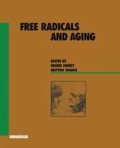Summary
Extracellular matrix molecules, such as collagens, are good targets for oxygen free radicals. Collagen is the only protein susceptible to fragmentation by superoxide anion as demonstrated by the liberation of small 4-hydroxyproline-containing-peptides. It seems likely that hydroxyl radicals in the presence of oxygen cleave collagen into small peptides, and the cleavage seems to be specific to proline or 4-hydroxyproline residues. Hydroxyl radicals in the absence of oxygen or hypochlorous acid do not induce fragmentation of collagen molecules, but they trigger a polymerization of collagen through the formation of new cross-links such as dityrosine or disulfure bridges. Morever, these cross-links can not explain the totality of high molecular weight components generated under these experimental conditions, and the nature of new cross-links induced by hydroxyl radicals or hypochlorous acid remains unclear.
Access this chapter
Tax calculation will be finalised at checkout
Purchases are for personal use only
Preview
Unable to display preview. Download preview PDF.
References
Bailey, A. J., Rhodes, D. N., and Cater, C. W. (1964) Irradiation-induced crosslinking of collagen. Radiation Res. 22: 606–621.
Boguta, G., and Dancewicz, A. M. (1983) Radiolytic and enzymatic dimerization of tyrosyl residues in insulin, ribonuclease, papain and collagen. Int. J. Radiat. Biol. 43: 249–265.
Borel, J. P. (1991) Les collagènes. L,Eurobiologiste 15: 247–271.
Davies, K. J. A. (1987) Protein damage and degradation by oxygen radicals. I-General aspects. J. Biol. Chem. 262: 9895–9901.
Davies, K. J. A., Lin, S. W., and Pacifici, R. E. (1987) Protein damage and degradation by oxygen radicals. IV. Degradation of denatured protein. J. Biol. Chem. 262: 9914–9920.
Dean, R. T., Wolff, S. P., and McElligott, M. A. (1989) Histidine and proline are important sites for free radical damage to proteins. Free Rad. Res. Commun. 7: 97–103.
Fligiel, S. E. G., Lee, E. C., McCoy, J. P., Johnson, K. J., and Varani, J. (1984) Protein degradation following treatment with hydrogen peroxide. Am. J. Pathol. 115: 418–425.
Fujimori, E. (1988) Cross-linking of collagen CNBr peptides by ozone and UV light. FEBS Lett. 235: 98–102.
Gillery, P., Monboisse, J. C., Maquart, F. X., and Borel, J. P. (1988) Glycation of proteins as a source of superoxide. Diab. Metab. 14: 25–30.
Girotti, A. W., Thomas, J. P., and Jordan, J. E. (1986) Xanthine-oxidase-catalyzed crosslinking of cell membranes proteins. Archs. Biochem. Biophys. 251: 639–653.
Greenwald, R. A., and Moy, W. W. (1979) Inhibition of collagen gelation by action of the superoxide radical. Arth. Rheum. 22: 251–259.
Halliwell, B. (1987) Oxidants and human disease: some new concepts. FASEB J. 1: 358–364.
Monboisse, J. C. (1989) Contribution à l’étude des interactions entre collagène et radicaux libres oxygénés. Thesis Univ. Reims.
Monboisse, J. C., Bellon, G., Dufer, J., Randoux, A., and Borel, J. P. (1987) Collagen activates superoxide anion production by human polymorphonuclear neutrophils. Biochem. J. 246: 599–603.
Monboisse, J. C., Bellon, G., Randoux, A., Dufer, J., and Borel, J. P. (1990) Activation of human neutrophils by type I collagen. Requirement of two different sequences. Biochem. J. 270: 459–462.
Monboisse, J. C., Braquet, P., Randoux, A., and Borel, J. P. (1983) Non enzymatic degradation of acid soluble collagen by superoxide anion: protective effect of fiavonoids. Biochem. Pharmacol. 32: 53–58.
Monboisse, J. C., Gardés-Albert, M., Randoux, A., Borel, J. P., and Ferrandini, C. (1988) Collagen degradation by superoxide anion in pulse and gamma radiolysis. Biochim. Biophys. Acta, 965: 29–35.
Monboisse, J. C., Garnotel, R., Randoux, A., Dufer, J., and Borel, J. P. (1991) Adhesion of human neutrophils to and activation by type I collagen involving a integrin. J. Leukoc. Biol. 50: 373–380.
Monboisse, J. C., Poulin, G., Braquet, P., Randoux, A., Ferradini, C., and Borel, J. P. (1984) Effects of oxy radicals on several types of collagen. Int. J. Tissue React. 6: 385–390.
Morel, F., Doussiére, J., and Vignais, P. (1991) The superoxide-generating oxidase of phagocytic cells. Physiological, molecular and pathological aspects. Eur. J. Biochem. 201: 523–546.
Schuessler, H., and Schilling, K. (1984) Oxygen effect in the radiolysis of proteins - Part 2 - Bovine serum albumin. Int. J. Radiat. Biol. 45: 267–281.
Van der Rest, M., and Garrone, R. (1990) Collagens as multidomain proteins. Biochimie 72: 473–484.
Vissers, M. C. M., and Winterbourn, C. C. (1991) Oxidative damage to fibronectin — I — The effects of the neutrophil myeloperoxidase system and HOCl. Archs. Biochem. Biophys. 285: 53–59.
Wolff, S. P., and Dean, R. T. (1986) Fragmentation of proteins by free radicals and its effect on their susceptibility to enzymic hydrolysis. Biochem. J. 234: 399–403.
Wolff, S. P., and Dean, R. T. (1987) Glucose autoxidation and protein modification. The potenteial role of “autoxidative glycosylation” in diabetes. Biochem. J. 245: 243–250.
Wolff, S. P., Garner, A., and Dean, R. T. (1986) Free radicals, lipids and protein degradation. TIBS 11: 27–31.
Author information
Authors and Affiliations
Editor information
Editors and Affiliations
Rights and permissions
Copyright information
© 1992 Birkhäuser Verlag Basel/Switzerland
About this chapter
Cite this chapter
Monboisse, J.C., Borel, J.P. (1992). Oxidative damage to collagen. In: Emerit, I., Chance, B. (eds) Free Radicals and Aging. EXS, vol 62. Birkhäuser Basel. https://doi.org/10.1007/978-3-0348-7460-1_32
Download citation
DOI: https://doi.org/10.1007/978-3-0348-7460-1_32
Publisher Name: Birkhäuser Basel
Print ISBN: 978-3-0348-7462-5
Online ISBN: 978-3-0348-7460-1
eBook Packages: Springer Book Archive

